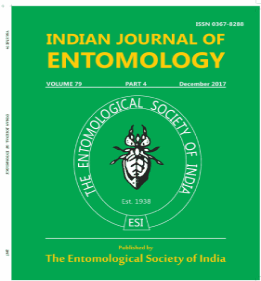Field Evaluation of Protein Bait in Attracting the Melon Fruit Fly Zeugodacus cucurbitae (Coquillett) in Snake Gourd
DOI:
https://doi.org/10.55446/IJE.2023.1576Keywords:
Zeugodacus cucurbitae, gel protein bait, liquid protein bait, cuelure, negative control, untreated control, snake gourd, attraction capacity, male to female ratio, evaporationAbstract
In India, melon fruit fly Zeugodacus cucurbitae Coquillett is a destructive insect pest of cucurbits. This study evaluated its attraction towards gel protein bait, an improvised version of liquid protein bait, found to be attractive in previous studies in snake gourd. Two field experiments were conducted for four months each (preliminary one - January to April, 2023; and confirmatory one - April to July, 2023). In early fruiting and fruiting stages, gel protein bait significantly attracted more females than the liquid protein bait; as regards male, cuelure trap attracted more followed by gel protein and liquid protein bait traps. Evaporation of gel protein bait in the field conditions was comparatively less from that of liquid protein bait.
Downloads
Metrics
Downloads
Published
How to Cite
Issue
Section
References
Bayoumy M H, El-Metwally M M. 2017. Daily flight activity rhythms of the peach and Mediterranean fruit flies using sexual and olfactory attractants. Acta Phytopathology et Entomology Hungarica 52: 227-244. DOI: https://doi.org/10.1556/038.52.2017.022
Chinajariyawong A, Kritsaneepaiboon S, Drew R A I. 2003. Efficacy of protein bait sprays in controlling fruit flies (Diptera: Tephritidae) infesting angled luffa and bitter gourd in Thailand. Raffles Bulletin of Zoology 51(1): 7-16.
Devi Y K, Ibrahim M M, Mehta P K. 2020. Laboratory evaluation of some indigenous raw materials for development of bait application technique (BAT) against fruit fly species, Bactrocera tau (Walker). Plant Archives 20(2): 1323-1328.
Enkerlin W R, Reyes-Flores J. 2018. Trapping guidelines for area-wide fruit fly programmes. FAO/IAEA.
Hagen K S, Franz J M. 1973. A history of biological control. Annual Review of Palocetto, California. pp. 433-467.
Indiastat: 2022. https://www.indiastat.com/data/agriculture/bitter-gourd/data-year/2022
Iqbal M, Gogi M D, Arif M J, Javed N. 2020. Attraction of melon fruit flies, Bactrocera cucurbitae (Diptera: Tephritidae) to various protein and ammonia sources under laboratory and field conditions. Pakistan Journal of Agricultural Sciences 57(4).
Jakhar S, Kumar V, Choudhary P K, Lal B. 2020. Estimation losses due to fruit fly, Bactrocera cucurbitae (Coquillett) on long melon in semi-arid region of Rajasthan.Journal of Entomology and Zoology Studies 8(6): 632-635.
Kapoor V C. 1993. Indian Fruit Flies. Oxford and IBH Publishing Co. Ltd. New Delhi. India. pp. 228-248.
Liyanage R, Nadeeshani H, Jayathilake C, Visvanathan R, Wimalasiri S. 2016. Comparative analysis of nutritional and bioactive properties of aerial parts of snake gourd (Trichosanthes cucumerina Linn.). International Journal of Food Science. DOI: https://doi.org/10.1155/2016/8501637
Manikantha J, Kavitha Z, Shanthi M, Subaharan K. 2022. Field evaluation of attractiveness of protein and food baits to the cucurbit fruit fly, Zeugodacus cucurbitae Coquilett. The Pharma Innovation 11(7): 4481-4486.
Maung K L, Mon Y Y, Khine M P, Chan K N, Phyoe A, Soe A T and Khai A A. 2019. Efficient Protein-based Bait Formulation for Attraction and Feeding Response of Fruit Flies (Diptera: Tephritidae) in Myanmar. Journal of Life Sciences 13: 18-24. DOI: https://doi.org/10.17265/1934-7391/2019.02.003
Mwatawala M W, De Meyer M, Makundi R H, Maerere A P. 2006. Biodiversity of fruit flies (Diptera, Tephritidae) in orchards in different agro-ecological zones of the Morogoro region, Tanzania. Fruits 61(5): 321-332. DOI: https://doi.org/10.1051/fruits:2006031
Mwatawala M W, De Meyer M, Makundi R H, Maerere A P. 2009. Host range and distribution of fruit-infesting pestiferous fruit flies (Diptera, Tephritidae) in selected areas of Central Tanzania. Bulletin of Entomological Research 99: 629-641. DOI: https://doi.org/10.1017/S0007485309006695
Pinero Jaime C, Steven K, Souder, Roger I, Vargas. 2020. Synergistic and additive interactions among components of food-based baits underlie female fruit fly attraction. Entomologia Experimentalis et Applicata 168(4): 339-348. DOI: https://doi.org/10.1111/eea.12890
Rajitha A R, Viraktamath S. 2005. Species diversity and relative abundance of fruit flies (Diptera: Tephritidae) in guava and mango orchards at Dharwad. National Conference on Animal Taxonomy-Emerging Trends, Kochi.
Ravikumar P, Viraktamath S. 2007. Attraction of female fruit flies to different protein food baits in guava and mango orchards. Karnataka Journal of Agricultural Sciences 20(4): 745.
Siderhurst M S, Jang E B.2010. Cucumber volatile blend attractive to female melon fly, Bactrocera cucurbitae (Coquillett). Journal of Chemical Ecology 36: 699-708. DOI: https://doi.org/10.1007/s10886-010-9804-4
Sruthi A B, Kavitha Z, Shanthi M, Beaulah A. 2023. Role of protein and food baits in attraction of melon fruit fly Zeugodacus cucurbitae in bitter gourd. Indian Journal of Entomology 455-458.
Tukey J W. 1977. Exploratory data analysis 2: 131-160.
Verghese A, Shivananda T N, Jayanthi P K, Sreedevi K. 2013. Frank Milburn Howlett (1877–1920): discoverer of the pied piper’s lure for the fruit flies (Tephritidae: Diptera). Current Science 105: 260-262.
















